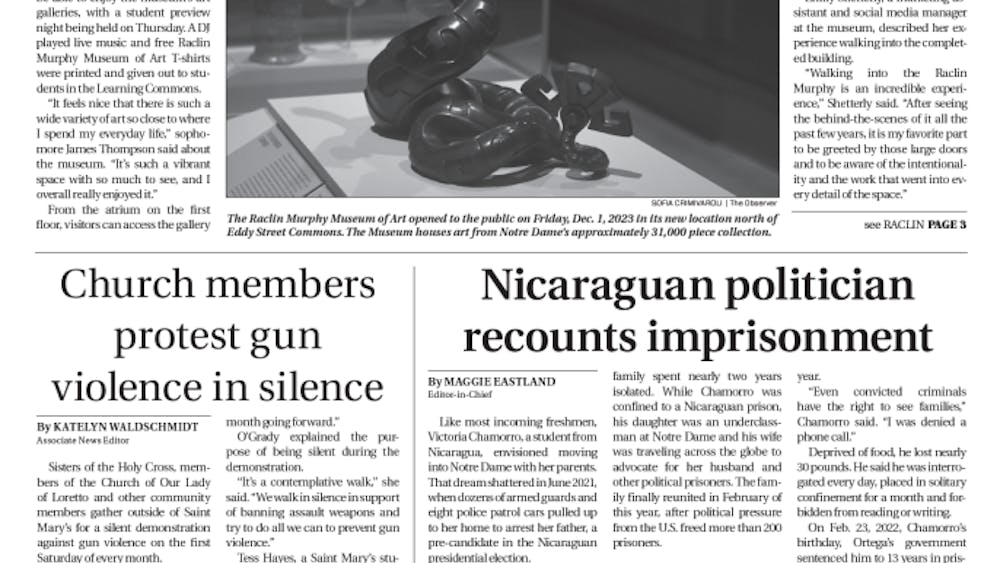Tempers flared and tensions surfaced as five Notre Dame faculty members and roughly 130 audience members met to debate affirmative action in the Jordan Auditorium Monday night. In an atmosphere that ranged from collaborative to combative, a panel comprised of assistant professor of political science Alvin Tillery, director of admissions Dan Saracino, director of Institutional Equity Rhonda Brown, associate director of the African American Studies Department Richard Pierce and Louis Crisostomo, a second-year law student and the president of the Notre Dame Federalist Society, was asked to defend their views on affirmative action and then to address questions and audience commentary that often boiled over into controversial territory.Saracino articulated Notre Dame's central argument in favor of affirmative action, saying that the University's current homogeneity contradicts its mission."This place does not accurately represent the world or the United States," Saracino said. "Ninety percent white is not providing an education for the leaders of tomorrow."He added that since racial clashes have dominated the affirmative action discussion, other "preferred" applicant groups such as legacies and the children of University donors are often overlooked."If you're black walking across campus, people automatically think you're here because of affirmative action. Part of me wants to require all of the other special admits to wear a sign on their backs that says [my parent is a] 'faculty member' or 'my name is the same as the one on that building,'" Saracino said to appreciative applause.As the speakers stepped outside of the Notre Dame context, a prevailing source of division amongst the panel members was the contrast between the constitutional text cited in affirmative action Supreme Court cases, such as Gratz v. Bollinger at the University of Michigan in 2003 and the University of California v. Bakke in 1978, and the reality of minorities' historical and everyday experience.While Crisostomo explained his own opposition to affirmative action on the grounds of constitutional principles, claiming that racial preference in admissions policies does not meet the "compelling government interest" requirement for legal justification, other panel members criticized his abstract approach."Affirmative action isn't about constitutional law. In reality, it's about a historical dialectic in American society between modernity and memory ... It reflects the tension between what was - and how we perceive what was - and what is," said Pierce, who was asked to step in for the other two representatives against affirmative action, both of whom backed out of the debate on Monday afternoon. In the spirit of academic exercise, Pierce departed from his personal views in order to represent those who oppose affirmative action on the grounds of ineffective policy. "Affirmative action is just not effective policy because it starts too late," he said. "If you want to improve someone's life, don't start when they're applying for college at age 16 or 17. Start at age three. Affirmative action should begin in preschool."Tillery, who supported current college admissions affirmative action policies, offered his views in a PowerPoint presentation that illustrated several benefits - including voting rights and the GI Bill - from which blacks had historically been excluded. He pointed out that the "strict judicial scrutiny" cited by Crisostomo has only been included in Constitution since 1977. "Is the Constitution always a colorblind document?" Tillery asked. "Is [1977 until now] enough time?"He referred to the metaphor of a man who has been "hobbled by chains" for centuries finally being called to the starting line of a race, saying the historical price paid by black Americans should not be overlooked in affirmative action arguments. Contemporary black experience of racism, he argued later, is equally relevant."If you circulate an application and your name is Kylie or Shenika, you are 50 percent less likely to get a call back than Todd Smith because they assume you're black," Tillery said in reference to a Harvard study. "African Americans share more experiences than you realize."Brown added that the reality of African-American experience, particularly at Notre Dame, should hold more weight than a "critical mass" or a quota.Paraphrasing Justice Stewart Potter's famous statement that he couldn't pinpoint what pornography was, "but I know it when I see it," Brown claimed that Notre Dame has a long way to go to achieve equal minority representation on campus."What is critical mass? I don't know what it is, but it's not here yet," Brown said heatedly, listing off situations from the classroom to the crew team where black students found themselves feeling isolated. "When we're all Domers from day one, then we have critical mass - and we'll fight until we get to that point."Pierce questioned how and when the point of equality would be determined. "If you support affirmative action, I would pose the question, how long should it exist?" he asked. "What are you going to mark as the signifiers of when it should end?"Saracino said that Notre Dame chooses to avoid such concrete deadlines, focusing instead on consistent progress toward a more diverse student body."Affirmative action is not quotas. Affirmative action is saying these are goals - and goals are laudable," he said. "I think we have a long way to go at Notre Dame in both socioeconomic and ethnic diversity, but we're making progress ... [We want] to be able to say we're farther ahead than we were the year before."
Read More
Trending









